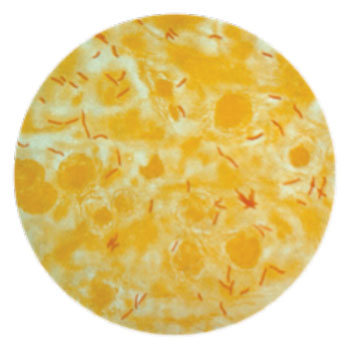Combining Drugs Reduces Toxicity of Key Anti-Tuberculosis Therapy Option
By LabMedica International staff writers
Posted on 15 Jan 2015
Combining a potent drug used to treat multidrug-resistant tuberculosis (TB) with a calcium-channel blocker significantly reduces the required dosage of the anti-tuberculosis drug, which eliminates most of its toxic side effects.Posted on 15 Jan 2015
While the drug bedaquiline was the first drug in more than 40 years to be approved by the [US] Food and Drug Administration for treatment of multidrug-resistant TB, it was given a black-box warning for arrhythmias that may cause cardiac arrest.

Image: Mycobacterium tuberculosis (stained red) in sputum from a human patient (Photo courtesy of the CDC - US Centers for Disease Control and Prevention).
Investigators at Johns Hopkins University (Baltimore, MD, USA) theorized that by combining bedaquiline with a second drug that blocks drug efflux pump proteins such as P-glycoprotein, it would be possible to increase the concentration of bedaquiline inside the Mycobacterium tuberculosis bacteria while reducing the overall dosage given to the patient.
To this end they looked at the efficacy of treating a mouse TB model with a drug cocktail comprising bedaquiline and verapamil. Verapamil is an L-type calcium channel blocker of the phenylalkylamine class that has been used in the treatment of hypertension, cardiac arrhythmia, and most recently, cluster headaches. Verapamil is used in cell biology research as an inhibitor of drug efflux pump proteins
Results published in the January 2015 issue of the journal Antimicrobial Agents and Chemotherapy revealed that the co-administration of verapamil with subinhibitory doses of bedaquiline gave the same bactericidal effect in mice as did the full human bioequivalent bedaquiline dosing. Adding verapamil to bedaquiline had the additional benefit of protecting against the development of resistant mutant strains of the bacteria.
"Using a mouse model of tuberculosis, we have shown lower doses of bedaquiline together with verapamil have the same antibacterial effect as the higher toxic doses," said first author Dr. Shashank Gupta, a research fellow at Johns Hopkins University. "A lower dose of bedaquiline will cause no or less severe side effects. Shortening treatment regimens and reducing the required doses may be a promising strategy to reduce the incidence of bedaquiline-related adverse effects and thereby improve multidrug-resistant TB treatment outcomes."
Related Links:
Johns Hopkins University










 (3) (1).png)



